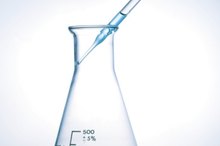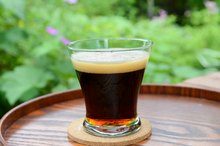Types & Uses of Alcohol
Depending upon the type, alcohol can be used for a beverage, a cleaning agent, first aid or as a fuel when camping and backpacking. For camp stoves, alcohol does not produce as much heat as other fuels, such as propane or white gas. However, it is generally considered safer, more widely available and less expensive than other fuels. When used with care, most alcohols can be a worthy addition to any camping or backpacking trip.
Ethyl Alcohol
Also called grain alcohol, grain neutral spirits, ethanol or rectified alcohol, ethyl alcohol can be purchased as an alcoholic beverage of a very high proof. These include brand names such as Everclear and Golden Grain and are typically 95 percent pure alcohol. These can be used as fuels for alcohol stoves, but may be very expensive and illegal to possess in some areas 1. It can also be purchased in its purest form from chemical or medical supply companies; however, because benzene, glycerin or other chemicals are required to remove the last amounts of water, these can be very toxic when used as fuels for alcohol stoves 1. While ethyl alcohol can be produced at home using distillation, the process is illegal in the United States.
- Also called grain alcohol, grain neutral spirits, ethanol or rectified alcohol, ethyl alcohol can be purchased as an alcoholic beverage of a very high proof.
- While ethyl alcohol can be produced at home using distillation, the process is illegal in the United States.
Methyl Alcohol
What is the Difference Between Ethyl Alcohol and Isopropyl Alcohol?
Learn More
Methyl alcohol, also called methanol, can be readily purchased in hardware stores as paint thinner and gas stations as gas line antifreeze. It makes a good fuel for alcohol stoves 1. It is also referred to as wood alcohol, camp stove fuel and methyl hydrate 1. The vapors of methyl alcohol are toxic and long-term use and contaminated stoves may cause inadvertent exposure 1. Be careful when stowing methyl alcohol near cooking utensils.
Isopropyl Alcohol
Isopropyl alcohol or isopropanol, commonly referred to as rubbing alcohol, can be found in pharmacies and grocery stores at concentrations of around 70 percent alcohol. This can be used as a cleaning agent and for first aid purposes. Isopropyl alcohol, though not recommended as a fuel for alcohol stoves can be used, if necessary. The concentration for isopropyl alcohol that is used as a fuel should be greater than 90 percent. This will generally burn poorly and incompletely, due to its water content.
- Isopropyl alcohol or isopropanol, commonly referred to as rubbing alcohol, can be found in pharmacies and grocery stores at concentrations of around 70 percent alcohol.
- Isopropyl alcohol, though not recommended as a fuel for alcohol stoves can be used, if necessary.
Gelled Alcohol
Types of Glycerin
Learn More
When methanol or ethanol are combined with a chemical called calcium acetate, it forms a gel. Sterno is a common brand name of gelled alcohol. This type of alcohol is traditionally used as a heat source for camp stoves 1. Because it is less likely to be spilled, gelled alcohol is generally considered safer than alcohol in liquid form. It usually comes in a canister with a wide-mouth lid that can be opened to allow the alcohol to be lit directly within the container. It can be replaced later to extinguish the fire.
- When methanol or ethanol are combined with a chemical called calcium acetate, it forms a gel.
- Because it is less likely to be spilled, gelled alcohol is generally considered safer than alcohol in liquid form.
Denatured Alcohol
Denatured alcohol is simply ethyl alcohol that has had some methyl alcohol or other chemicals added to it to make it undrinkable. This effectively removes it from the market as a taxable and legally controlled alcoholic beverage. Denatured alcohol may be used as a fuel for camp stoves, although other toxic chemicals may be added in the denaturing process 1. Check the label before you use any denatured alcohol as a fuel source.
- Denatured alcohol is simply ethyl alcohol that has had some methyl alcohol or other chemicals added to it to make it undrinkable.
- Check the label before you use any denatured alcohol as a fuel source.
Related Articles
References
- Zen Stoves: Zen and the Art of the Alcohol Stove
- Zen Stoves: Jelled/Gelled Alcohol Burners
- Ultralight Hiking: Triangia Alcohol Stoves
- National Institute on Alcohol Abuse and Alcoholism. Alcohol Metabolism: An Update. Alcohol Research & Health. 2007;30(1).
- Taylor B, Rehm J. The relationship between alcohol consumption and fatal motor vehicle injury: high risk at low alcohol levels. Alcohol Clin Exp Res. 2012;36(10):1827-34. doi:10.1111/j.1530-0277.2012.01785.x
- Ferré S, O'Brien MC. Alcohol and caffeine: The perfect storm. J Caffeine Res. 2011;1(3):153-162. doi:10.1089/jcr.2011.0017
- Stornetta A, Guidolin V, Balbo S. Alcohol-derived acetaldehyde exposure in the oral cavity. Cancers (Basel). 2018;10(1):20. doi:10.3390/cancers10010020
- Hadland SE, Levy S. Objective testing: Urine and other drug tests. Child Adolesc Psychiatr Clin N Am. 2016;25(3):549-65. doi:10.1016/j.chc.2016.02.005
- Stewart SH, Koch DG, Willner IR, Randall PK, Reuben A. Hair ethyl glucuronide is highly sensitive and specific for detecting moderate-to-heavy drinking in patients with liver disease. Alcohol Alcohol. 2013;48(1):83-7. doi:10.1093/alcalc/ags109
- Fillmore MT, Jude R. Defining "binge" drinking as five drinks per occasion or drinking to a .08% BAC: which is more sensitive to risk? Am J Addict. 2011;20(5):468-75. doi:10.1111/j.1521-0391.2011.00156.x
- American Association for Clinical Chemistry. Ethanol. 2018.
- Cederbaum A. Alcohol metabolism. Clinics in Liver Disease. 2012;16(4):667-685. doi:10.1016/j.cld.2012.08.002
- LabCorp, Inc. Drugs of Abuse Reference Guide. 2007.
- National Institute on Alcohol Abuse and Alcoholism. Alcohol Metabolism: An Update. Alcohol Research & Health. 2007;30(1).
Writer Bio
In Jacksonville, Fla., Frank Whittemore is a content strategist with over a decade of experience as a hospital corpsman in the U.S. Navy and a licensed paramedic. He has over 15 years experience writing for several Fortune 500 companies. Whittemore writes on topics in medicine, nature, science, technology, the arts, cuisine, travel and sports.









